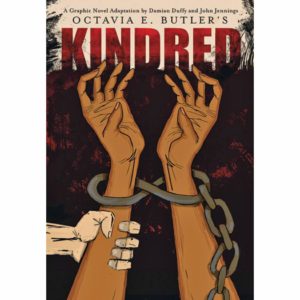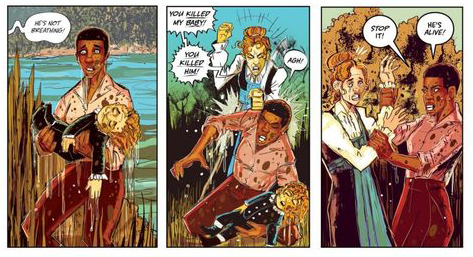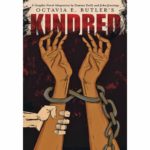Writers: Octavia E. Butler, Damian Duffy
Artist: John Jennings
Colorist: John Jennings
Letterer: John Jennings
Designer: Pamela Notarantonio
Editor: Sheila Keenan
Publisher: Abrams ComicArts
It is an arresting image to open any book with: a woman lying on what looks like a hospital bed, staring out at the reader with one arm across her lap, the other amputated at her elbow. “I lost an arm on my last trip home,” reads the panel. And, with that, one is plunged headlong into a 240-page graphic adaptation of a classic.
Kindred is a science-fiction novel full of ideas that grapples with powerful questions. They involve race and the notion of identity. They involve sociological shifts in how America has evolved. They also involve capitalism, which lies at the heart of what gave rise to the shameful practice of slave trading. The vehicle for these ideas is a young black woman trying to make her living as a writer in 1976. Dana is married to a white man named Kevin, and she is suddenly sucked back in time to America before the Civil War. The method of time travel isn’t explained, because it is not the point. Dana wakes up in a Maryland plantation, where she is forced to confront one of her own ancestors called Rufus Weylin, the son of a plantation owner.

Time shifts constantly as Dana is pulled and pushed through the past, appearing and disappearing whenever Weylin finds himself in danger. What seems like years in Maryland passes by in minutes whenever she returns home. Her stays start to get longer though, and more dangerous, as she begins to recognize how potentially short-lived life can be for a black woman on a plantation. Her husband is eventually pulled back too, but he experiences a more privileged life as a white man. His story adds perspective to Dana’s, acting as an effective foil that throws her altered circumstances into sharp relief.
Adapting a much-loved text to a different medium is never easy, and one can imagine how difficult it must have been for writer Damian Duffy and illustrator John Jennings to take on Octavia E. Butler’s much-loved, award-winning original. Butler passed away in 2006, so there was no input from her on how to transpose her ideas from prose to visuals.

Some of the methods used by Jennings involve separating the past from the present through color and the quality of sketches, with muted tones and rough lines for life at the plantation as opposed to sharper, more vivid images for Dana’s present. The action — slaves being whipped, families separated to be sold — is brought more easily to life, and it manages to shed insight not just into the dehumanization of black people but also on the complexities of their troubled relationships with those their so-called masters.

Does Kindred need a graphic adaptation? Probably not. It’s great that one exists though, if only for the possibility of new generations waking up to the existence of the original and to Butler’s commendable body of work. When one takes into account the fact that it was first published in 1979, it’s painful to acknowledge that the questions it raised four decades ago are still relevant. Then again, that is precisely what makes it a classic.




